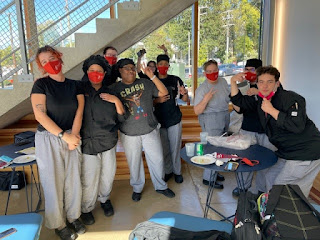Model or Mindset?
A coordinated care approach to advising
Recent studies have established that students are more likely to succeed when they meet with advisors.*
Revision? It's more than that.
Change? Yes, but it's more than that, too.
A 360-degree turn? Yes, that's about it.
While Reynolds "new" advising model was officially launched last October during Advising Month, its vision had been percolating in the minds of Bernadette Battle and her Advising team for almost two years. That's when "Bern" arrived on campus as Associate Dean of Advising Services.
But, to call the model "new" and a "model" doesn't adequately tell the story. "New" is true; the transition is still in "proposal" stage - yet its changes are already evident. It's a "Model" in that it's a formulation of thought, yet it's greater than just a collection of ideas. What is happening in Advising is more of a 360-degree perspective pivot, than simply another model.
It's not enough to simply offer advising. To be effective, advisors need to reach out to students, to be proactive, or as the new Advising Proposal states be "intrusive" in connecting with students. President Pando calls it, being a student's "person". This is advising in its "relational" form, as opposed to its "transactional" form. As Bern says, this is advising that starts with building a relationship. And it is a model that relies on two essential "T" elements: Teamwork and Technology.
"Connections and collaboration are key," says Master Advisor Coordinator, and Professor of Health and Physical Education, Dr. Robin Shepherd, "the silos are coming down. We are working together as a network. This is one of the major differences in what we are doing now. It's a culture shift."
Like every network these days, the success of advising relies heavily on technology. In addition to social media, email (less effective with students), text messages, and phone calls, advisors reach out via Navigate. Navigate has been available to the college for about four years, but its use has been akin to driving a Ferrari like a minivan. In the hands of the current advising team these programs are being driven in the ways they were intended, to connect with, and help students daily, and hourly if needed, and to reach students where they are.
Another extremely critical element of this model is moving students from their initial advisor to their faculty advisor. Since the relationship aspect is so personal, that handoff to a new "person" must be handled smoothly. Because the silos are coming down, and all areas are working together for the common goal of each student's success, this should be a seamless transition. Again, the flexibility of the model is key. If that transition isn't working, faculty and staff come together to figure out what steps to take next.
While phased implementation is in progress, this shift in mindset is already evident in the spirit of the Advisors and those who work with them. How could they resist the energy and enthusiasm of their staunchest advocate and leader, Bern Battle? Student surveys are positive, and the numbers of students seeking advising is on the rise. All good, and strong indicators of success. Stay tuned. There will be more to come about this exciting change at the college from Advising Services and our Master Advisors!
Read the Advising Proposal here.
*EAB Blog Post, Who could benefit the most from more advising? by Kiersten Chuc and Ed Venit, April 21, 2021


